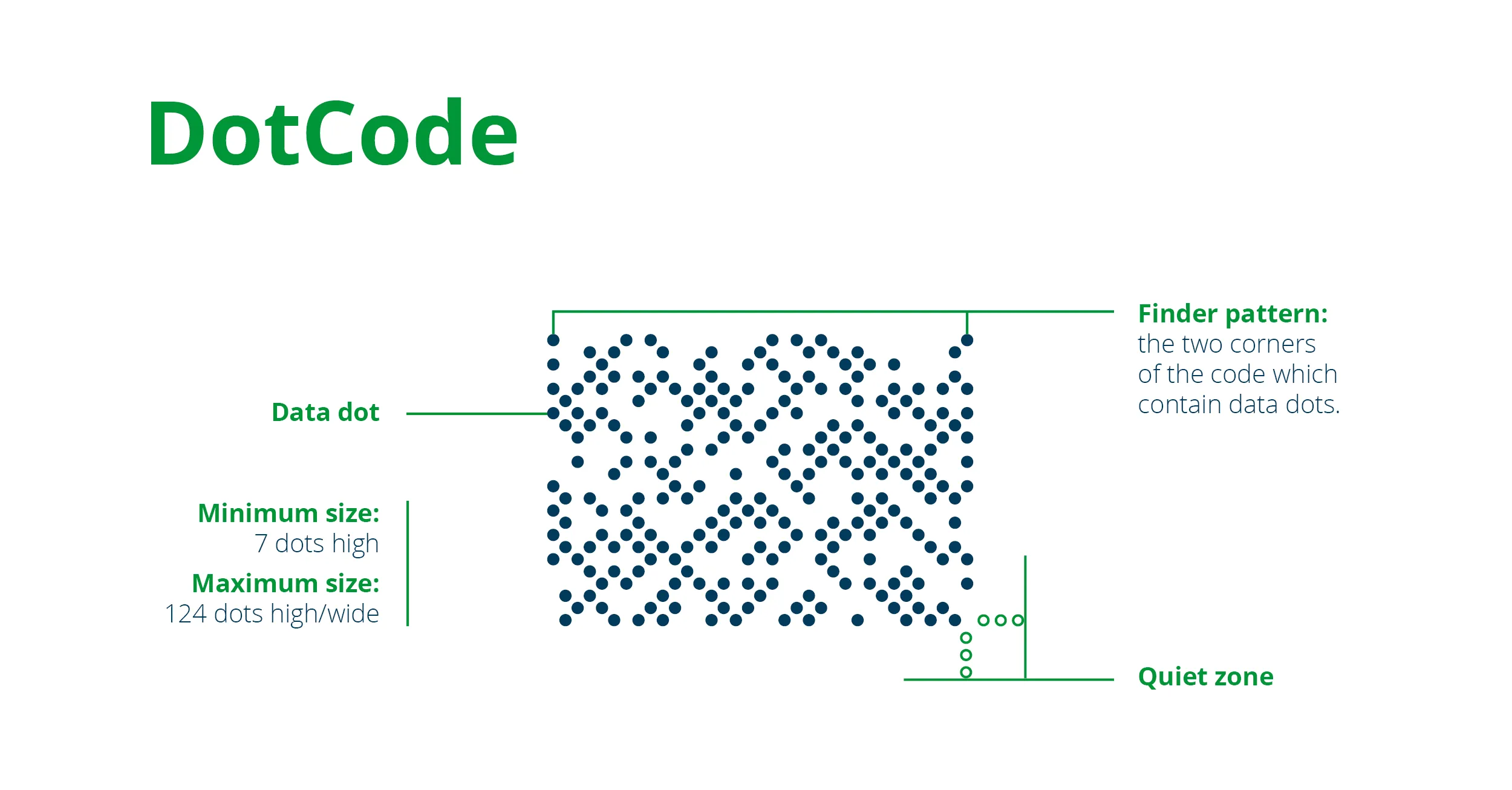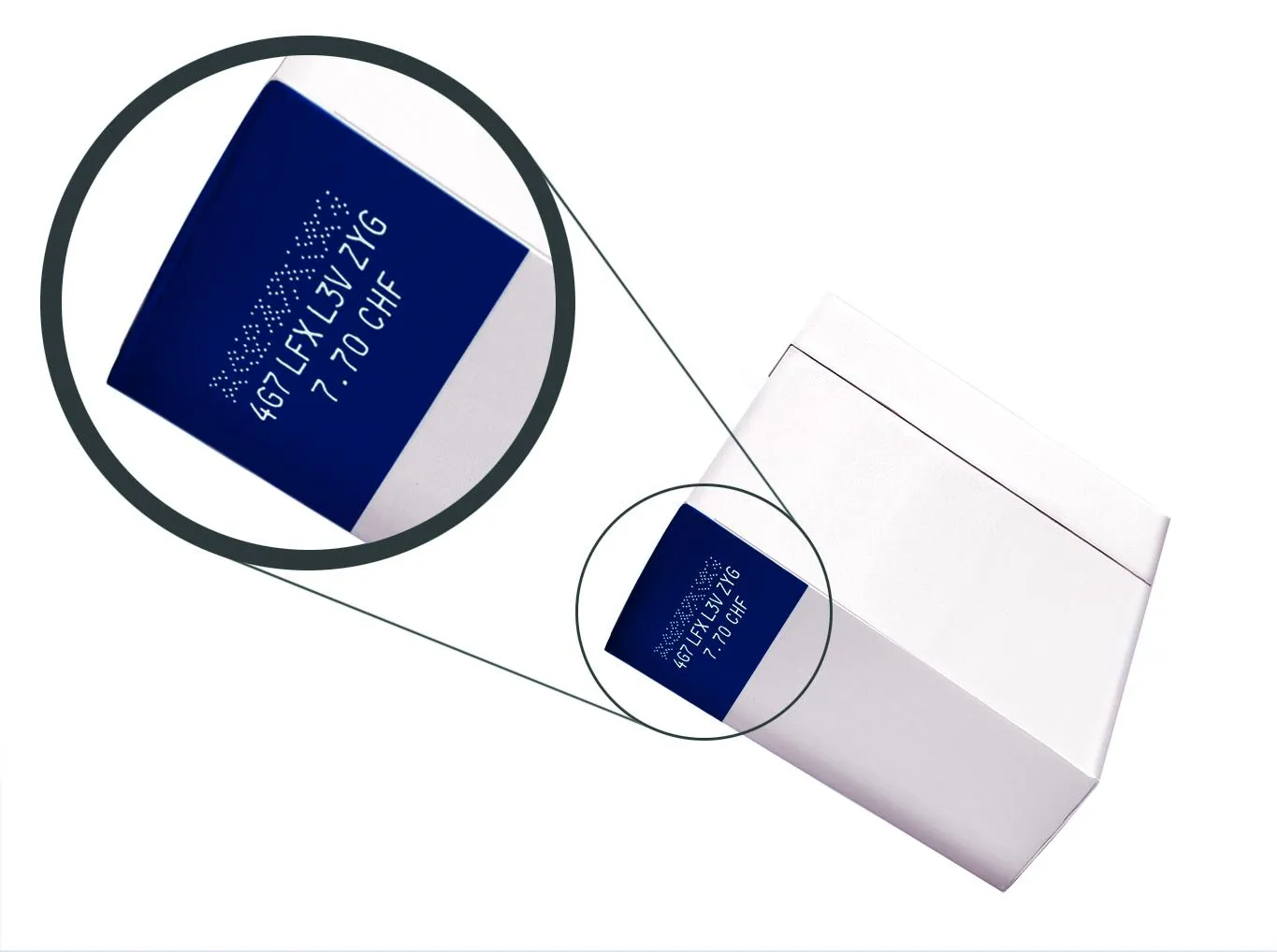If you read our last '2D Codes Explained' blog, you will already know a bit about Data Matrix codes, QR codes, and their potential uses in a range of different industries. There are a host of other 2D codes out there – each of which brings its own unique opportunities and limitations.
In our latest blog, we take a look at a lesser known 2D barcode symbology – the DotCode, a relatively new player on the 2D code scene, developed for use in very specific, high-throughput applications.
What is a DotCode?
The DotCode is 2D barcode which encodes data in dots in a rectangular array. It was originally developed as a solution for a machine-readable code that could be read reliably when printed using high-speed inkjet or laser technologies.
In industries with high-speed production processes, DotCodes can be used as an alternative to other 2D codes to facilitate item-level serialisation allowing products to be tracked throughout global supply chains.
The DotCode was developed by Dr Andrew Longacre, with official specifications published by global industry standards organisation AIM in 2009.
DotCodes are public domain codes – this means that they are not restricted by copyright and are royalty free, so organisations do not require a license in order to print or use the code. Up to date specifications are available from AIM under ISS DotCode Symbology Specification 4.0.
Like other 2D codes, DotCodes are equipped with error correction capabilities using the Reed-Solomon correction algorithm, which works to detect and restore missing data in 2D codes. This means that DotCodes can still be read if part of the code is missing or damaged.
What does a DotCode code look like?

Unlike many other 2D codes, DotCodes are usually rectangular in shape. The data in DotCodes is encoded in ‘data dots’. Data dots can be either square or circular and are positioned on a grid diagonal to the rectangle.
The sizing and orientation of DotCodes are flexible, however the dot height, and width of the code must be odd – if, for example, there is an odd number of dots in the height of the code, then there must be an even number in the width, and vice versa.
DotCodes can be printed in dark colours on a light-coloured background, or in light colours on a dark-coloured background, providing that there is sufficient contrast to ensure readability.
The minimum size for a DotCode is 7 dots high – in theory, there is no maximum size, however, the practical limit achievable by most printing technology would be 124 dots in either direction.
Like other 2D codes, DotCodes have a ‘finder pattern’, this can be seen in the two corners of the code which contain data dots – the location of these dots allows a data reader, or scanner, to know where to start reading the data.
A DotCode must be surrounded by a ‘quiet zone’, which is three dots wide, on all four sides of the printed code. The empty space ensures that a scanner can effectively scan and read the code without picking up any additional printed content.
What data can a DotCode contain?
DotCodes can encode data using all 7-bit ASCII (American Standard Code for Information Interchange) characters, as well as all extended 8-bit ASCII characters – representing numerals 0 to 9, lowercase letters a to z, uppercase letters A to Z, punctuation symbols, and a range of special characters.
Unlike other 2D codes, DotCodes are not technically limited to any functional capacity with regards to data capacity. There is no fundamental maximum capacity to the amount of data that can be stored in a DotCode, though in practice, printers are likely to be restricted to a size limit of 124 dots in either direction, as mentioned above.

What’s the best technology for printing DotCodes?
Unlike other 2D codes, DotCodes do not require the use of continuous lines or precise spacing, and, as such they can be reliably applied with high-speed coders, including industrial inkjet printers and laser coding systems, including CO2 and fibre lasers . This makes the codes well suited to industries with high-speed production lines.
How do you scan a DotCode?
Like Data Matrix codes and QR codes, DotCodes can be scanned from any orientation using a specialist 2D code scanner, or camera scanner. DotCodes can also be scanned using the camera on a smart phone or tablet, provided there is a suitable barcode reader app installed – however, DotCodes are not typically recommended for use in consumer-facing applications.
What industries are DotCodes used for?
DotCodes have been used to great success for on-pack serialisation in the European tobacco industry – where fast paced production environments (often producing up to 1,000 packs per minute) require a high-speed product marking solution.
GS1 – the global standards organisation – maintains global standards for DotCodes for use in tobacco applications, for meeting the requirements of the EU tobacco traceability regulation EU 2018/574.
While the most prominent use of DotCode is within the tobacco sector, the codes’ suitability for use in fast-paced production environments could prove useful for other industries with high-speed printing requirements – such as alcoholic beverages – where serialisation may become a requirement in the future.
How can I find out more about using DotCodes?
If you are considering adding a DotCode, or any kind of 2D code, to your product packaging and need more information on how best to do this please get in touch.
We have a range of different printing and labelling solutions to suit the requirements for all industries, and packaging types. We also offer a range of specialist code verification systems, to ensure that codes meet print quality requirements, and which can be used to check data accuracy for serialised codes.
If you are working in an industry with high-speed serialisation requirements, and are interested in exploring the use of DotCodes, our experts are on hand to talk through your specific requirements and discuss which solution is right for your business.